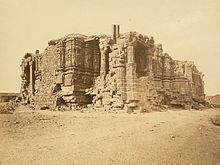| Attack on Somnath temple | |||||||
|---|---|---|---|---|---|---|---|
| Part of Ghaznavid campaigns in India | |||||||
 Ruins of Somnath as viewed in 1869 | |||||||
| |||||||
| Belligerents | |||||||
| Ghaznavids | Chaulukya dynasty | ||||||
| Commanders and leaders | |||||||
| Mahmud of Ghazni | Bhima I | ||||||
| Strength | |||||||
| 60,000 | Unknown | ||||||
| Casualties and losses | |||||||
| Unknown | 50,000 | ||||||
Location within Gujarat | |||||||
The Sack of Somnath in 1026 was a military campaign orchestrated by Mahmud of Ghazni, a ruler of the Ghaznavid Empire, directed against the Chaulukya dynasty of Gujarat. This is considered Mahmud's fifteenth invasion of India, which saw strategic captures and decisive battles and culminated in the destruction of the revered Somnath Temple. Facing staunch resistance, Mahmud's forces emerged victorious, resulting in significant casualties.
Entering Somnath in mid-January, Mahmud looted and burned the temple, earning him the title 'The Idol Breaker". This event remains a historical symbol of cultural clash and religious desecration during Mahmud's military campaigns in medieval India.

